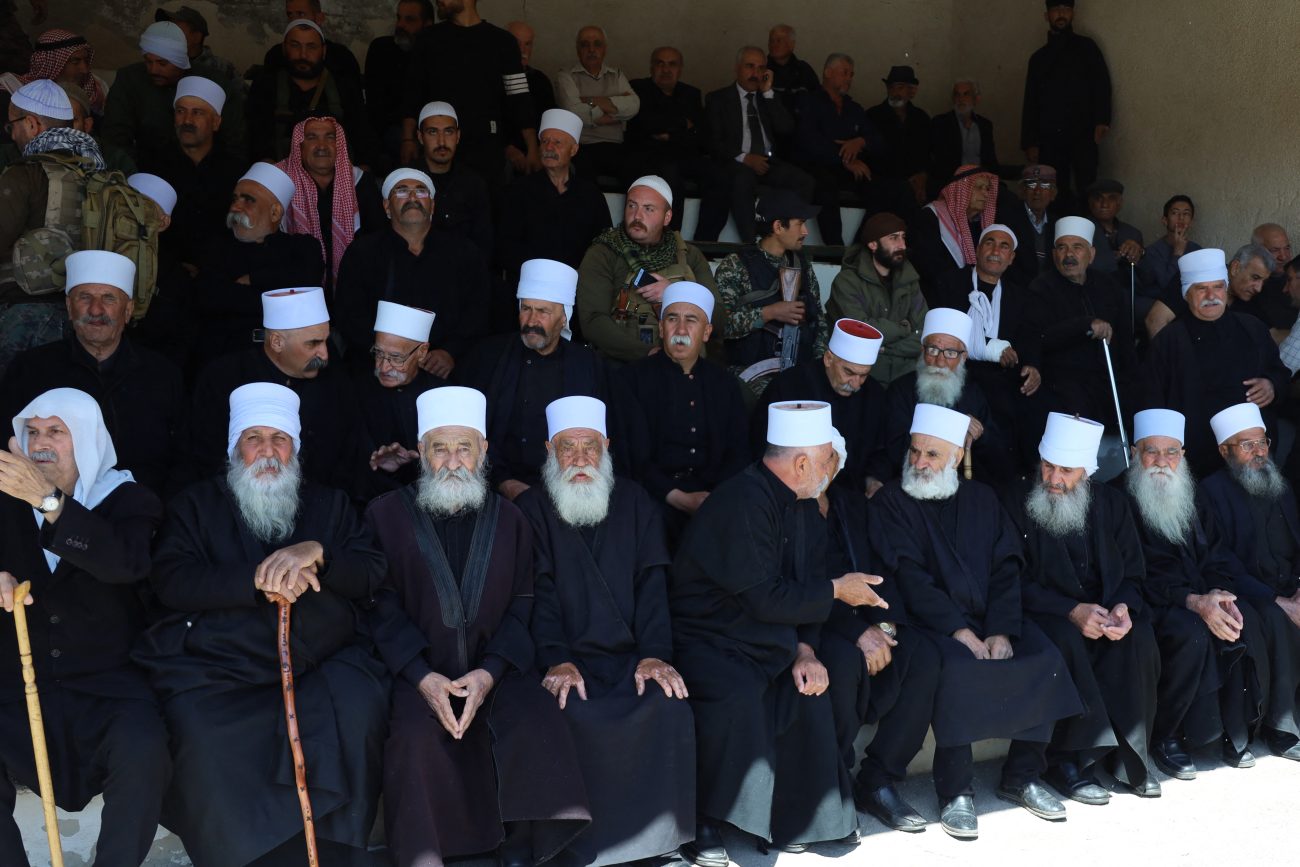Another Attack On Druze People! Who Are Middle’s East Druze Community Characterized By Black & White Outfit

A monitoring group said Syrian government forces killed 12 Druze civilians when they stormed a family’s guest house in Sweida city on Tuesday.
“Members of the defence and interior ministries carried out field executions of 12 citizens after storming the Radwan family guest house in the city of Sweida,” said the Syrian Observatory for Human Rights, a Britain-based monitor with sources on the ground.
An unverified video clip circulating on social media showed at least 10 people in civilian clothes covered in blood inside a guest house. Pictures of Druze dignitaries lay scattered around the room, alongside damaged furniture.
The Druze are a prominent religious community of more than a million people spread across Syria, Lebanon, and Israel, who for centuries have sought to preserve a distinct identity.
In Syria, Druze fighters have clashed both with neighbouring Bedouin tribes and with forces loyal to the Islamist government, as they have struggled to find their place in the new order ushered in by the December overthrow of longtime president Bashar al-Assad.
Israel’s bombardment of government forces deployed to the community’s Sweida province following the latest unrest has further complicated Druze relations with the ruling Islamists.
Israel says it is acting to protect the minority community, a claim challenged by most Druze outside Israel as well as the Damascus authorities.
Here is a brief look at Druze beliefs and history:
Religion & Customs
The Druze emerged in Egypt in the early 11th century as a branch of the Ismaili sect of Shiite Islam.
They are monotheistic and call themselves “muwahhidun”, or unitarians.
The sect is highly secretive and incorporates mystical elements, including a belief in reincarnation. It does not allow new converts, and marriage outside the community is strongly discouraged.
A source familiar with Druze rituals, who requested anonymity to discuss matters considered sensitive, said the faith’s emergence was influenced by other religious and philosophical teachings, including those of the Greek philosopher Plato.
Some Druze religious occasions align with those of other Islamic sects.
Traditional Druze attire is characterized by black clothing, with men wearing white caps or turbans and women covering their heads and part of their faces with a flowing white scarf.

Where Are They?
“The Druze don’t really recognise borders,” said Makram Rabah, assistant professor of history at the American University of Beirut.
“You have marriages and you have standing relationships between the Druze across the region,” he said, adding that “clerics play a very important role in keeping this relationship alive.”
Before civil war erupted in Syria in 2011, the community was estimated to number around 700,000.
According to “The Druze Faith” by historian Sami Makarem, Druze have been migrating to southern Syria since the 16th century, to an area now known as Jabal al-Druze, meaning Druze Mountain, in Sweida province.
Syria’s Druze are now mainly concentrated in their Sweida heartland, as well as nearby Quneitra province, with smaller pockets in the Damascus suburbs, notably Jaramana and Sahnaya, which saw sectarian violence earlier this year.
In Lebanon, an estimated 200,000 Druze are concentrated in the mountainous centre as well as in the south near Israel and Syria.
In Israel, some 153,000 Druze are Israeli citizens, living mainly in the north. Unlike other Arab Israelis, Druze serve in the Israeli army.
In the Israeli-occupied Golan Heights, seized from Syria in 1967, more than 22,000 Druze hold permanent resident status.
Only around 1,600 have taken up the offer of Israeli citizenship. The rest maintain their Syrian identity.
Some Druze from southern Syria have settled in neighbouring Jordan, where the community is estimated to number between 15,000 and 20,000.
Two delegations of Syrian Druze clerics have made pilgrimages to a holy site in Israel this year.
Outside the Middle East, a Druze diaspora exists, particularly in North America and Australia. Well-known Druze include prominent human rights lawyer Amal Alamuddin Clooney and Jordanian Foreign Minister Ayman Safadi.
Leading Role
Despite their minority status, Druze “have filled an important and sometimes a leading role in the political and social life” of the Middle East, according to historian Makarem.
In Syria, Druze Sultan Pasha al-Atrash led a nationalist revolt against the French mandatory power, which had established a Druze statelet in southern Syria during the 1920s and 1930s.
In Lebanon, Druze leader Kamal Jumblatt played a key role in politics from the 1950s until his assassination in 1977, and his son Walid is a powerful politician.
In April, Jumblatt urged Syria’s Druze to reject “Israeli interference”, after Israel warned the Islamists who ousted Assad against harming the minority.
Druze leaders have declared their loyalty to a united Syria, though some have called for international protection.
Israeli Druze spiritual leader Sheikh Mowafaq Tarif has urged Israel to protect Syria’s Druze.
Rabah said there was a Druze “power struggle across three states”, adding that he believes Syria’s community does not aspire to statehood.
The Druze largely stayed on the sidelines of the Syrian civil war, focusing on defending their heartland. Most Druze armed groups have yet to reach a settlement with the new authorities.
- Questions and Answers
- Opinion
- Motivational and Inspiring Story
- Technology
- Live and Let live
- Focus
- Geopolitics
- Military-Arms/Equipment
- Безопасность
- Economy
- Beasts of Nations
- Machine Tools-The “Mother Industry”
- Art
- Causes
- Crafts
- Dance
- Drinks
- Film/Movie
- Fitness
- Food
- Игры
- Gardening
- Health
- Главная
- Literature
- Music
- Networking
- Другое
- Party
- Religion
- Shopping
- Sports
- Theater
- Health and Wellness
- News
- Culture

